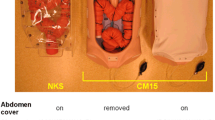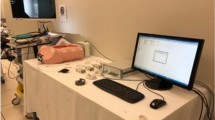Abstract
Background
Colonoscopy insertion is difficult to teach due to the inability of current training models to provide realistic tactile sensation with simultaneous three-dimensional (3D) colonoscope display.
Aims
To assess the influence of a simulator consisting of a colon model coupled with 3D instrument visualization on trainee colonoscopy performance.
Methods
Pilot study using the simulator model with three trainees who were not proficient in colonoscopy. At random times over a 6-week period, trainees participated in an individualized half-day session using the Colonoscope Training Model and a colonoscope equipped with a 3D magnetic probe imaging system (ScopeGuide) in six standardized cases. A blinded supervising instructor graded patient-based colonoscopy performance over the 6-week period, and we independently analyzed the 2-week period before and after the intervention. We also measured cecal intubation and withdrawal times and medication requirements.
Results
Trainees performed 86 patient-based colonoscopies. Following the intervention, the colonoscopy performance score improved from 4.4 ± 2.3 to 5.9 ± 2.4 (p = 0.005). Trainees had a 76% cecal intubation rate following the session as compared to 43% before training (p = 0.004), while utilizing less time, 14 ± 7 versus 18 ± 11 min (p = 0.056) and less medication (p > 0.05).
Conclusions
Colonoscopy simulation using the Colonoscope Training Model and the ScopeGuide produced an immediate and large effect on trainee colonoscopy performance.





Similar content being viewed by others
References
Faigel DO, Pike IM, Baron TH, et al. Quality indicators for gastrointestinal endoscopic procedures: an introduction. Am J Gastroenterol. 2006;101:866–872.
Lieberman D. A call to action–measuring the quality of colonoscopy. N Engl J Med. 2006;355:2588–2589.
Bowles CJ, Leicester R, Romaya C, Swarbrick E, Williams CB, Epstein O. A prospective study of colonoscopy practice in the UK today: are we adequately prepared for national colorectal cancer screening tomorrow? Gut. 2004;53:277–283.
Shah SG, Brooker JC, Williams CB, Thapar C, Saunders BP. Effect of magnetic endoscope imaging on colonoscopy performance: a randomised controlled trial. Lancet. 2000;356:1718–1722.
Shah SG, Saunders BP. Aids to insertion: magnetic imaging, variable stiffness, and overtubes. Gastrointest Endosc Clin N Am. 2005;15:673–686.
Shah SG, Thomas-Gibson S, Lockett M, et al. Effect of real-time magnetic endoscope imaging on the teaching and acquisition of colonoscopy skills: results from a single trainee. Endoscopy. 2003;35:421–425.
American Association for the Study of Liver Disease, American College of Gastroenterology, American Gastroenterology Association Institute, American Society for Gastrointestinal Endoscopy. The Gastroenterology Core Curriculum, 3rd ed. Gastroenterology; 2007:1–64.
Gerson LB. Evidence-based assessment of endoscopic simulators for training. Gastrointest Endosc Clin N Am. 2006;16:489–509, (vii–viii).
Cotton PB. Simulators in competence assessment and credentialing: prospects and problems. Gastrointest Endosc Clin N Am. 2006;16:577–581, (ix).
Sedlack RE, Kolars JC. Computer simulator training enhances the competency of gastroenterology fellows at colonoscopy: results of a pilot study. Am J Gastroenterol. 2004;99:33–37.
Di Giulio E, Fregonese D, Casetti T, et al. Training with a computer-based simulator achieves basic manual skills required for upper endoscopy: a randomized controlled trial. Gastrointest Endosc. 2004;60:196–200.
Park J, MacRae H, Musselman LJ, et al. Randomized controlled trial of virtual reality simulator training: transfer to live patients. Am J Surg. 2007;194:205–211.
Hochberger J, Matthes K, Maiss J, Koebnick C, Hahn EG, Cohen J. Training with the compactEASIE biologic endoscopy simulator significantly improves hemostatic technical skill of gastroenterology fellows: a randomized controlled comparison with clinical endoscopy training alone. Gastrointest Endosc. 2005;61:204–215.
Vittinghoff E, Glidden DV, Shiboski SC, McCulloch CE. Regression methods in biostatistics. Springer: Linear, Logistic, Survival and Repeated Measures Models; 2005.
Author information
Authors and Affiliations
Corresponding author
Appendices
Appendix 1

Appendix 2

Appendix 3

Rights and permissions
About this article
Cite this article
Kaltenbach, T., Leung, C., Wu, K. et al. Use of the Colonoscope Training Model with the Colonoscope 3D Imaging Probe Improved Trainee Colonoscopy Performance: A Pilot Study. Dig Dis Sci 56, 1496–1502 (2011). https://doi.org/10.1007/s10620-011-1614-1
Received:
Accepted:
Published:
Issue Date:
DOI: https://doi.org/10.1007/s10620-011-1614-1




